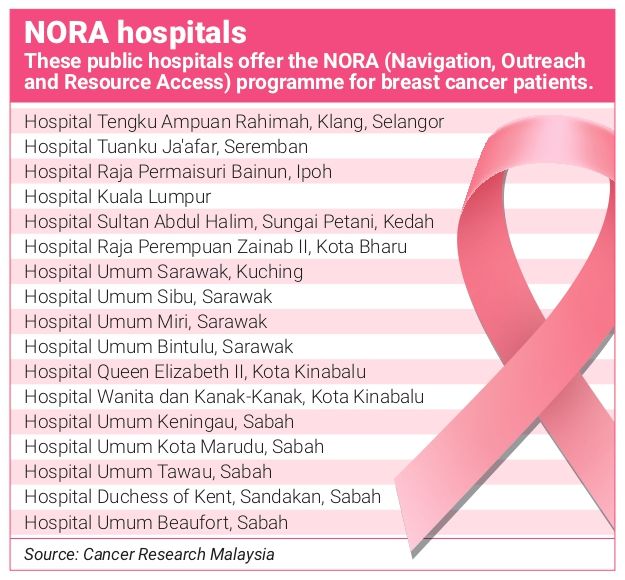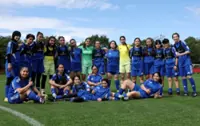Hani offers emotional and practical support to a breast cancer patient under the Nora programme at Hospital Tengku Ampuan Rahimah. — HANI ZAINAL
Confusion. Panic. Silence.
That’s the usual reaction when someone hears the words: “You have breast cancer.”
For many women, those words mark the beginning of fear and uncertainty.
But imagine if at the other end of the phone, a calm voice speaks.
“You are not alone,” says the nurse navigator gently.
“We’ll walk through this journey with you together, every step of the way.”
Helping new patients
Behind this network of quiet support is Cancer Research Malaysia (CRMY) Community Outreach head Dr Jananezwary Kanapathy.
“In Malaysia, one in 30 women is expected to develop breast cancer in her lifetime,” she says.
“Yet, our five-year survival rate remains among the lowest in the region, showing that we must do more to support our patients.”
That’s where Nora, short for Navigation, Outreach and Resource Access, comes in.
Formerly known as the Patient Navigation Programme (PNP), Nora has evolved into an initiative covering over half the states in the country, transforming how Malaysian women experience breast cancer care.
“Nora’s mission is simple: to ensure that no woman is left behind, regardless of where she lives or what she earns,” says Dr Jananezwary.
“This is a patient-centred programme designed to guide newly-diagnosed breast cancer patients so that they can focus on their treatment without being overwhelmed by the barriers they face.”
For many women, those barriers – lack of awareness, emotional distress, financial strain and logistical challenges – can cause dangerous delays in seeking treatment.
“Unfortunately, that has been Malaysia’s reality for far too long,” she adds.
“Where we live often determines whether we survive cancer, and that’s simply not fair.”
Fear of treatment
At the Pink Ribbon Centre in Hospital Tengku Ampuan Rahimah, Klang, Selangor, nurse navigator Hani Zainal has spent seven out of her 17 years in nursing dedicated to helping breast cancer patients navigate the healthcare system.
Her role goes far beyond clinical care.
“When we first meet patients, we assess what might stop them from finishing treatment,” she explains.
“Once we identify those barriers, we connect them to the right support.”
Many women arrive in shock after their diagnosis – confused and terrified.
“They often don’t understand the medical terms doctors use.
“So we take time to explain everything: what chemotherapy is, how long it takes, and what they can expect,” she says.
She recalls one patient who delayed treatment after turning to alternative medicine.
“Her husband was a fisherman, and she was willing to borrow money for traditional therapy.
“She was scared to come to the hospital because she thought doctors would scold her for being late,” Hani shares.
“She’d heard people say, ‘If you do chemo, you’ll die.’
“That kind of fear and stigma is still very real.”
ALSO READ: Do traditional or alternative treatments really cure breast cancer?
Even educated women hesitate, Hani adds.
“They know the importance of treatment, but fear and family responsibilities often hold them back.”
Some patients abandon treatment midway and only return when their condition worsens.
“That’s what we don’t want,” she says.
“Delays make treatment less effective.
“If caught early, treatment is smoother – surgery, chemotherapy, radiotherapy, and then hormone therapy.”
Barriers beyond the disease
The cost and logistics of treatment can also be overwhelming.
“Government hospitals are subsidised, but it’s not completely free,” Hani notes.
“Chemotherapy typically costs around RM100 per session, with an average of six cycles, though the amount can vary.
“Radiotherapy is also much cheaper in public hospitals, about RM12 per session, but patients may need between 15 and 30 sessions.”
Mammograms and biopsies, however, are free for local patients.
In contrast, private hospital costs can reach RM12,000 for radiotherapy and RM20,000 to RM30,000 for surgery, Hani says, recalling her experience working in a private setting.
Still, many patients in government hospitals struggle with hidden costs like transport and food.
Some patients travel long distances for appointments.
“We once arranged a trip from Klang to the National Cancer Institute in Putrajaya that cost RM150 for a return journey,” shares Hani.
The Nora team provides financial assistance to help patients with treatment and transportation costs, which are funded by CRMY, Yayasan Petronas and Yayasan Sime Darby.
However, if a patient has already received support from other sources such as mySalam, the team will focus on assisting with transport arrangements instead.
mySalam is a social health protection scheme designed to support low-income groups in Malaysia.
Even after completing treatment, follow-up care remains vital.
“We tell patients, ‘Even if you don’t want to continue chemotherapy, the doctor still needs to see you to monitor your condition.’
“We never just let them go,” Hani says.
She explains that breast cancer often causes no pain in its early stages.
“It only becomes painful when it’s advanced, when the tumour swells or breaks the skin.
“At that point, surgery is needed, but chemotherapy must first be done to shrink the tumour.”
Zero defaulters, real results
Despite the challenges, most patients complete their treatment once they receive proper guidance and support.
Breast and Endocrine Surgery National Head of Service Datuk Dr Imi Sairi shares that Hospital Raja Perempuan Zainab II in Kota Baru recorded zero treatment defaulters this year (2025).
“We used to have around 20% of patients defaulting every year, who didn’t return for treatment,” he says.
“Now, that number has drop-ped to zero.”
He credits the success to the nurse navigators.
“I used to get frustrated with patients who defaulted because there was no one assigned to follow up; no one to check why they didn’t come back for chemotherapy or radiotherapy.
“But now we have two amazing navigators working closely with a very dedicated hospital team,” he says.
“They keep calling patients, even visiting their villages if needed, to encourage them to return for treatment.
“Doctors and nurses don’t always have the time to do that, but navigators bridge that gap.”
“People ask if this is just a collaboration,” he adds.
“I tell them, no, it’s a marriage. One that’s built to last.”
How Nora works
Dr Jananezwary explained that Nora operates through three phases:
- Hospital-based – ensuring that hospitals are prepared to guide patients through the process and provide timely diagnoses and treatment before ramping up awareness and referrals.
- Primary care – training Health Ministry personnel to make rapid referrals so that patients showing symptoms can be sent directly to the nearest Pink Ribbon Centre for diagnostic assessment, often within a few days.
- Community phase – empowering women to come forward early for screening and treatment, either at clinics or directly to hospitals.
Each Nora hospital (see list above) is connected to the nearby Klinik Kesihatan, Klinik Desa, Pusat Komuniti and private clinics.
When a clinic detects a suspicious lump, the patient is referred to the nearest hospital offering breast surgery and mammogram services.
If that hospital is full, she is sent to the next closest Health Ministry facility.
At the hospital’s Pink Ribbon Centre, the patient will be connected to a nurse navigator, who will guide and support her throughout her breast cancer journey.






